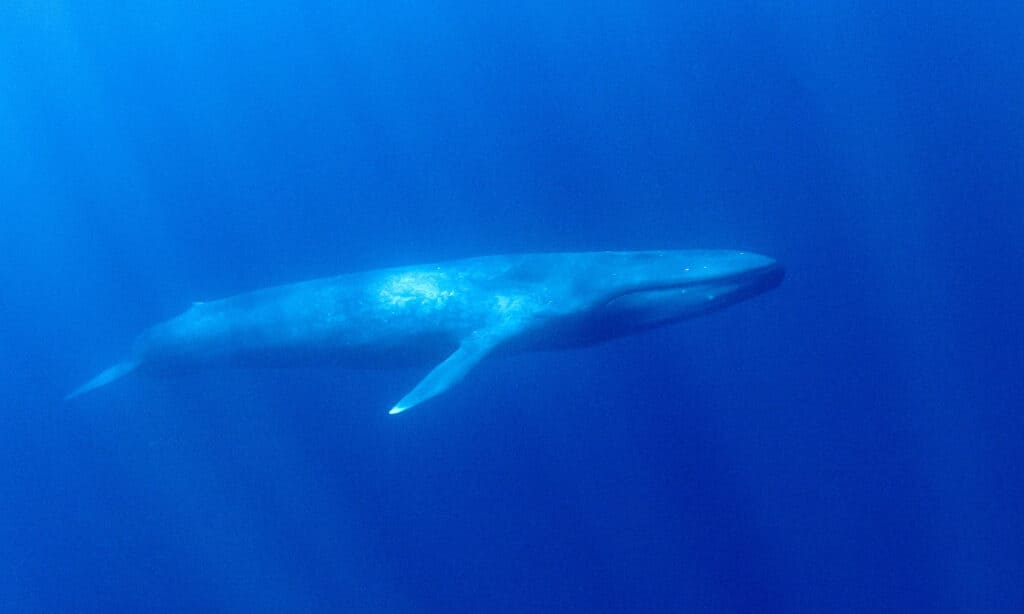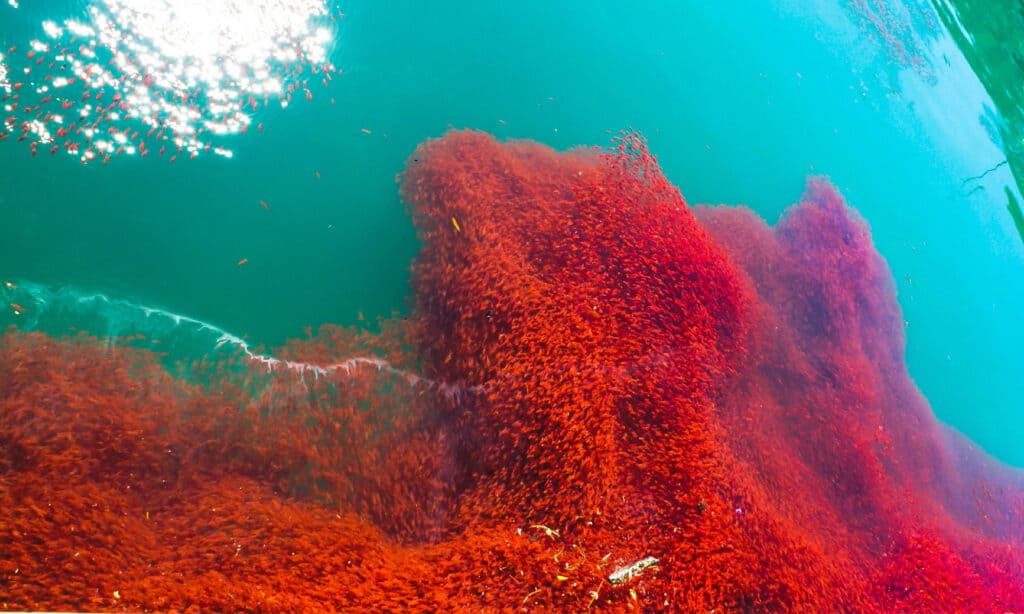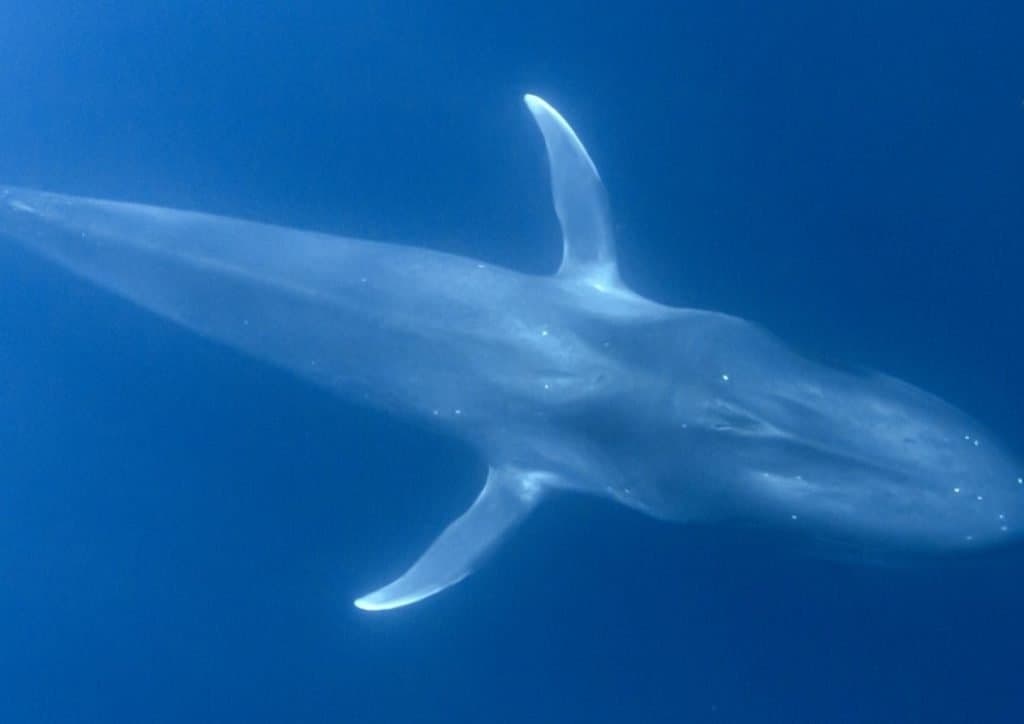Blue whales are one of the largest animals ever to exist. These mammals grow up to 98 feet long, making them almost as large as history’s largest animals, such as the Patagotitan mayorum. Blue whales are marine mammals that weigh up to 330,000 pounds, a feat no other animal has achieved.
In addition to being the heaviest animals ever to exist, these animals are among the loudest in the world. This article uncovers some weird facts about these marine monsters, including everything you’ve ever wanted to know about blue whale poop.
Blue Whales: The Heaviest Animals to Ever Exist

Blue whales weigh up to 330,000 pounds and are the heaviest animals ever.
©iStock.com/richcarey
In 2019, a blue whale fossil of an 85-foot specimen was found in Italy, and scientists dated the fossil back more than 1.5 million years. Although this is the oldest blue whale fossil ever found, blue whales could have existed centuries earlier.
Blue whales are grayish-blue and have long and slender submarine-like bodies. These animals are among the loudest in the world, and this isn’t only because they make sounds as loud as 188 decibels, but also because their hearts which are as big as cars, can be heard beating from up to 2 miles away.
Like all mammals, blue whales breathe oxygen they take in through their blowholes, similar to our noses. They take in air at the surface every 5 to 15 minutes but can go for 60 to 90 minutes without air.
What Do Blue Whales Eat?

Blue whales eat about 8,000 pounds of krill daily.
©Apple Pho/Shutterstock.com
Considering how large these mammals are, it’s normal to wonder just what they eat. Blue whales feed almost exclusively on krill. Krill are small crustaceans that weigh about 0.04 ounces (1.1 grams) and are about 0.4 and 1.6 inches long. Blue whales eat a lot of krill, consuming about 8,000 pounds daily.
Blue whales consume food through a method called filter-feeding. They have expandable throats that can swallow unbelievable amounts of water mixed with prey; even heavier than their own body weight. Their large tongue strains the water out and takes in the fish.
What Does Blue Whale Poop Look Like?

Blue whale poop is pink, looks like small pebbles, feels like bread crumbs, and smells as bad as dog poop.
©iStock.com/izanbar
Blue whale poop is a pinkish color mainly because of the krill it eats. When blue whales have to go, they swim and beat their tails along the water as they drop their pebble-like poop.
According to multiple reports, blue whale poop has the consistency of bread crumbs and smells as bad as dog poop. Their urine is just as unique; it is colored a bright yellow-green that borders on neon. Each time, they can pass out up to 200 liters of urine.
Blue whale poop contains key nutrients for the ocean’s well-being. It creates ‘pastures’ that krill and other small fish eat, and it also helps create algae which are important for marine life.
Is Blue Whale Poop Important?
As we’ve explained, blue whale poop is full of nutrients. Some of these nutrients are released into the ocean as they poop, fertilizing the ecosystem. It is also responsible for feeding many animals such as krill, phytoplankton, penguins, birds, jellyfish, seals, and even other whales.
According to the National Museum of Natural History, the hunting and killing of whales directly results in less krill population. This is because krill (and many other animals) depend on whales and their excreta to survive. By eating krill and then pooping, whales release iron locked within krill back into the water, making that iron available to phytoplankton, which need it to survive.
Do Blue Whales Eat Their Own Poop?

Whales haven’t been documented eating their own poop.
©Eric Gropp / flickr – License
Whales aren’t known to eat their own poop. This is normally done by animals when they feel they have missed nutrients. However, blue whales have not been documented doing this. As we’ve mentioned, krill, which blue whales eat, feed on their waste. So, in a way, they indirectly feed on their poop.
Is Blue Whale Poop Toxic To Humans?

Blue whale poop is vital to the ocean’s health.
©Rich Carey/Shutterstock.com
Blue whale poop is a very vital part of the ocean’s health. It has many benefits and is an important part of the ecosystem. Blue whale poop is not toxic, but if you’re handling it, you’re better off wearing a glove since it is still poop, after all.
Does Blue Whale Poop Make a Good Fertilizer?
Blue whales like to feed on krill because of how much iron it contains. The Swim Guide states that such large amounts of iron as blue whales eat would lead to poop that is full of nutrients. This makes it an excellent fertilizer for the ocean as it restores its lost nutrients.
Up Next:
Blue Whale vs. Killer Whale: What Are The Differences?
10 Incredible Blue Whale Facts
Lion Poop: Everything You’ve Ever Wanted To Know
The photo featured at the top of this post is © Atomic Roderick/Shutterstock.com
Sources
- NOAA Fisheries, Available here: https://www.fisheries.noaa.gov/species/blue-whale
- Royal Society Publishing, Available here: https://royalsocietypublishing.org/doi/10.1098/rsbl.2019.0175
Thank you for reading! Have some feedback for us? Contact the AZ Animals editorial team.






